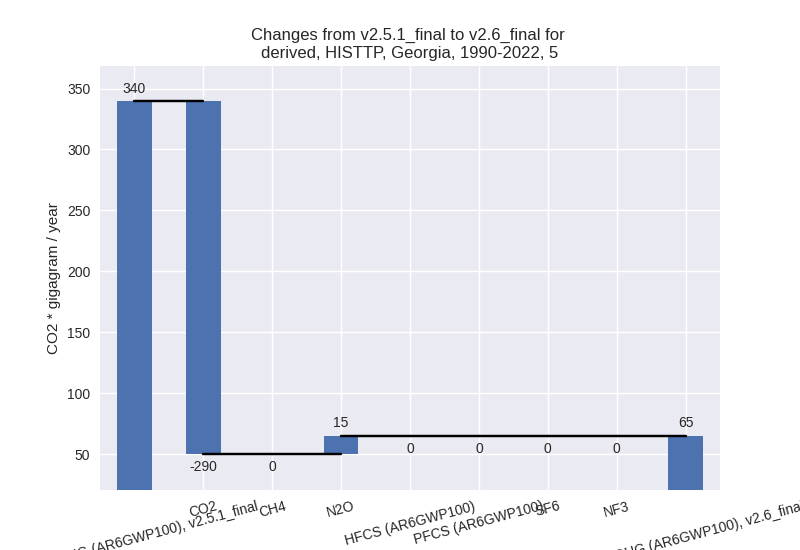Changes in PRIMAP-hist v2.6_final compared to v2.5.1_final for Georgia
2024-09-24
Johannes Gütschow
Change analysis for Georgia for PRIMAP-hist v2.6_final compared to v2.5.1_final
Overview over emissions by sector and gas
The following figures show the aggregate national total emissions excluding LULUCF AR6GWP100 for the country reported priority scenario. The dotted linesshow the v2.5.1_final data.
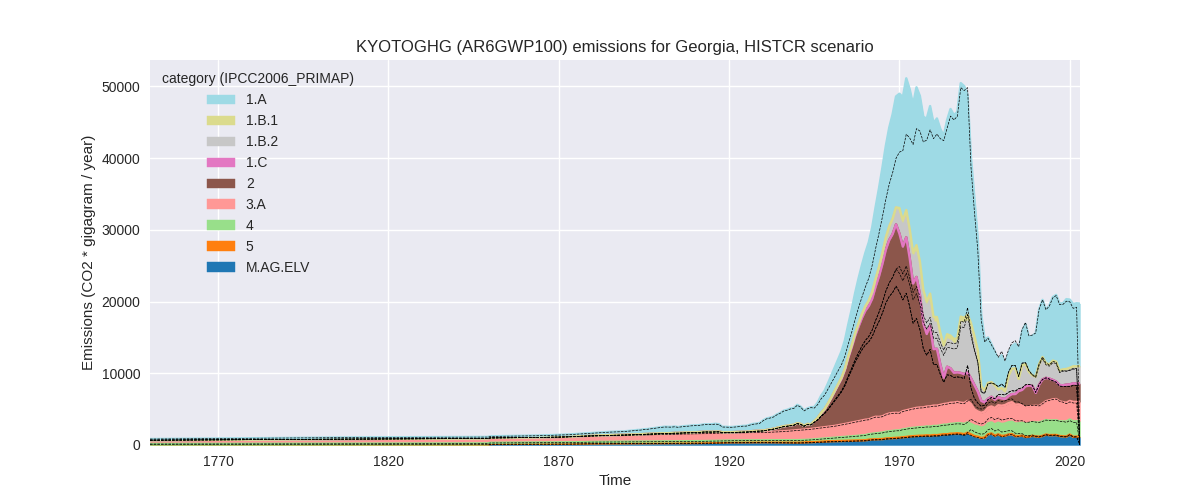

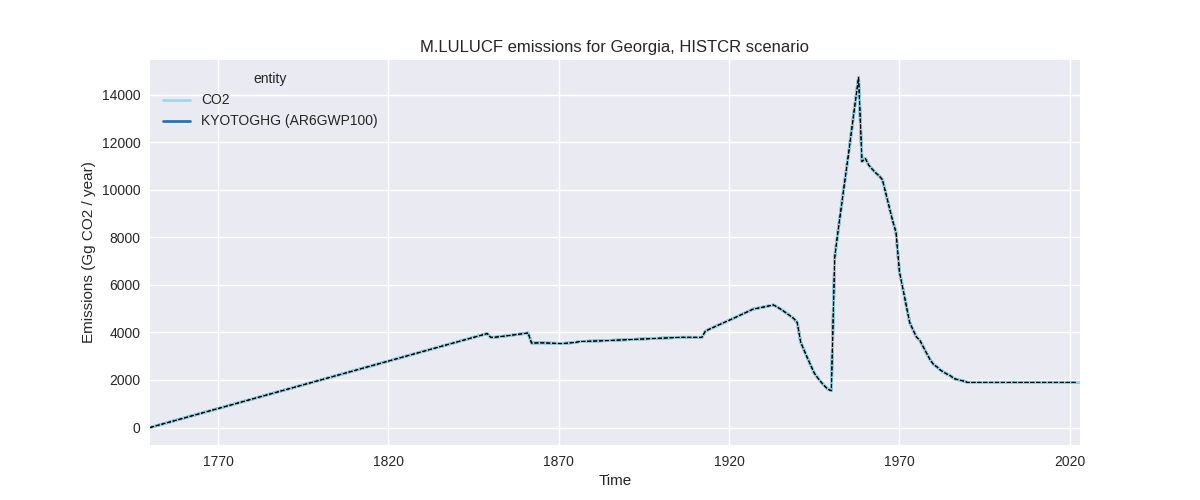
The following figures show the aggregate national total emissions excluding LULUCF AR6GWP100 for the third party priority scenario. The dotted linesshow the v2.5.1_final data.
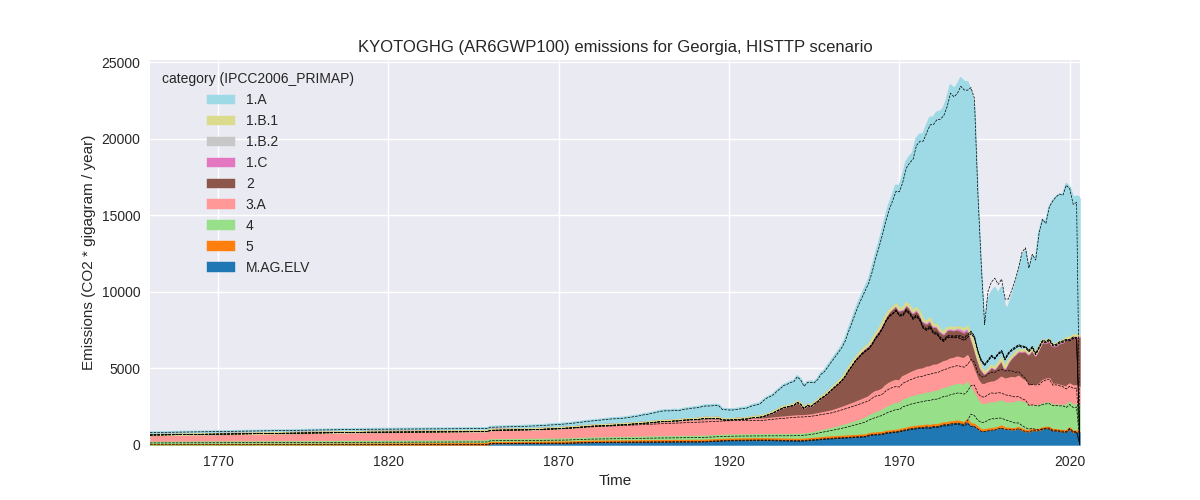
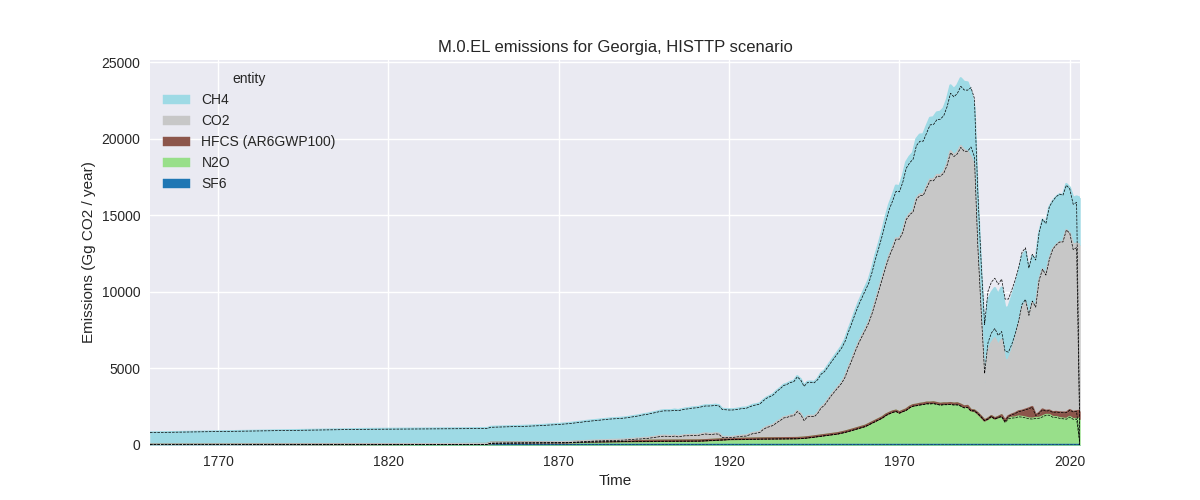
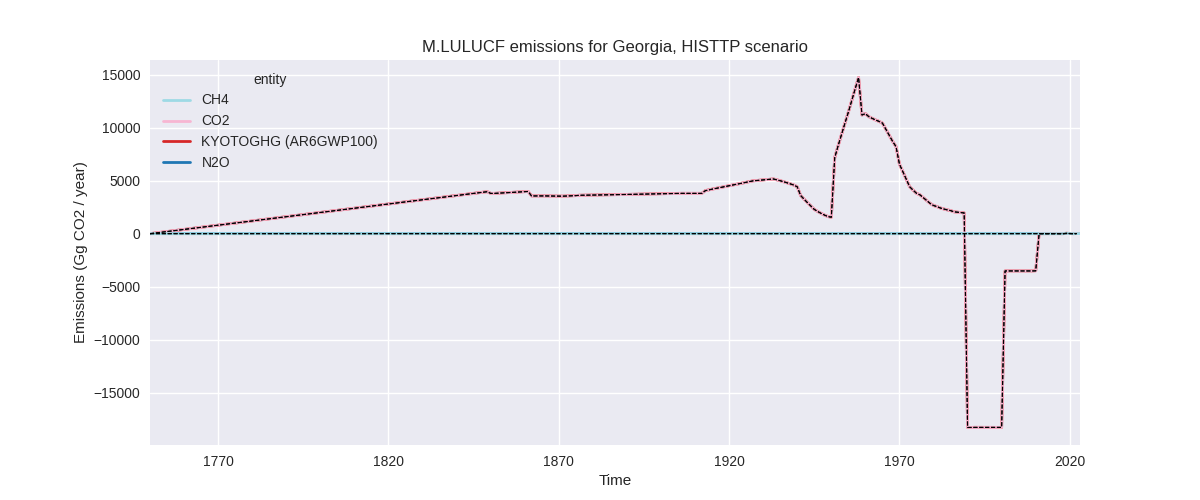
Overview over changes
In the country reported priority scenario we have the following changes for aggregate Kyoto GHG and national total emissions excluding LULUCF (M.0.EL):
- Emissions in 2022 have changed by 2.9%% (562.72 Gg CO2 / year)
- Emissions in 1990-2022 have changed by 0.5%% (96.98 Gg CO2 / year)
In the third party priority scenario we have the following changes for aggregate Kyoto GHG and national total emissions excluding LULUCF (M.0.EL):
- Emissions in 2022 have changed by 2.4%% (384.04 Gg CO2 / year)
- Emissions in 1990-2022 have changed by -1.6%% (-227.39 Gg CO2 / year)
Most important changes per scenario and time frame
In the country reported priority scenario the following sector-gas combinations have the highest absolute impact on national total KyotoGHG (AR6GWP100) emissions in 2022 (top 5):
- 1: 1.A, CO2 with 279.27 Gg CO2 / year (3.3%)
- 2: 4, CH4 with 155.04 Gg CO2 / year (8.0%)
- 3: 2, CO2 with 118.43 Gg CO2 / year (7.2%)
- 4: 2, CH4 with 9.55 Gg CO2 / year (10526.0%)
- 5: 5, N2O with -7.50 Gg CO2 / year (-11.9%)
In the country reported priority scenario the following sector-gas combinations have the highest absolute impact on national total KyotoGHG (AR6GWP100) emissions in 1990-2022 (top 5):
- 1: 5, CO2 with -289.64 Gg CO2 / year (-100.0%)
- 2: 2, CO2 with 269.82 Gg CO2 / year (21.4%)
- 3: 2, N2O with 61.30 Gg CO2 / year (12.1%)
- 4: 1.A, CO2 with 17.67 Gg CO2 / year (0.2%)
- 5: 4, CH4 with 17.41 Gg CO2 / year (1.0%)
In the third party priority scenario the following sector-gas combinations have the highest absolute impact on national total KyotoGHG (AR6GWP100) emissions in 2022 (top 5):
- 1: 1.A, CO2 with 289.22 Gg CO2 / year (3.3%)
- 2: 4, CH4 with 116.86 Gg CO2 / year (7.6%)
- 3: 2, CO2 with -19.92 Gg CO2 / year (-1.0%)
- 4: 5, N2O with -7.50 Gg CO2 / year (-11.9%)
- 5: 4, N2O with 5.16 Gg CO2 / year (10.7%)
In the third party priority scenario the following sector-gas combinations have the highest absolute impact on national total KyotoGHG (AR6GWP100) emissions in 1990-2022 (top 5):
- 1: 5, CO2 with -289.64 Gg CO2 / year (-100.0%)
- 2: 4, CH4 with 37.47 Gg CO2 / year (2.3%)
- 3: 1.A, CO2 with 18.30 Gg CO2 / year (0.3%)
- 4: 5, N2O with 15.06 Gg CO2 / year (30.2%)
- 5: 2, CO2 with -10.75 Gg CO2 / year (-1.1%)
Notes on data changes
Here we list notes explaining important emissions changes for the country. ’' means that the following text only applies to the TP time series, while means that it only applies to the CR scenario. Otherwise the note applies to both scenarios.
- 2022 changes for energy CO2 due to updated EI data.
- Country reported data for CH4 in 2.C had to be removed because the downscaling did not work properly due to inconsistent sector coverage. Now EDGAR 8.0 data are used leading to much higher cumulative and 2022 emissions (CR scenario).
- Some CO2 and N2O data in IPPU subsectors had to be removed as well (for the same reason as CH4) leading to changes in 2022 and cumulative emissions (CR scenario). This also impacts pre-1990 emissions as it affects that value for harmonization of pre-1990 emissions to country reported data.
- Changes in sectors 4 and 5 are due to the removal of FAOSTAT data.
Changes by sector and gas
For each scenario and time frame the changes are displayed for all individual sectors and all individual gases. In the sector plot we use aggregate Kyoto GHGs in AR6GWP100. In the gas plot we usenational total emissions without LULUCF. ## country reported scenario
2022
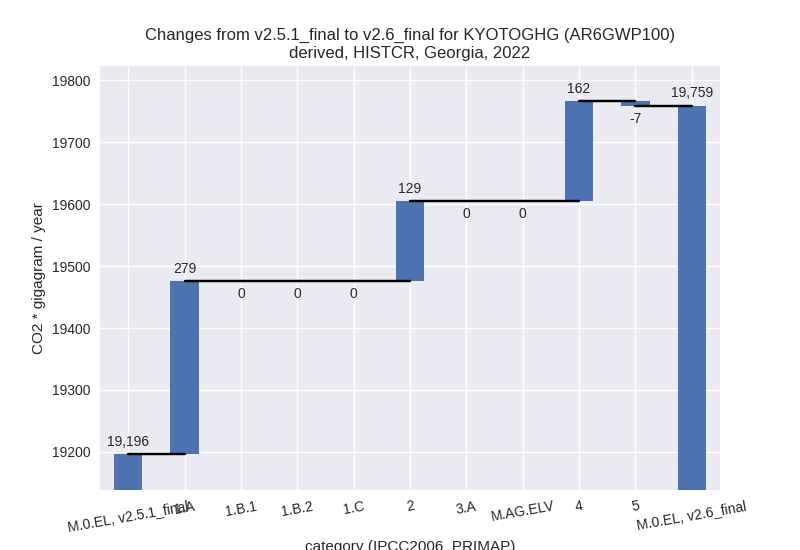
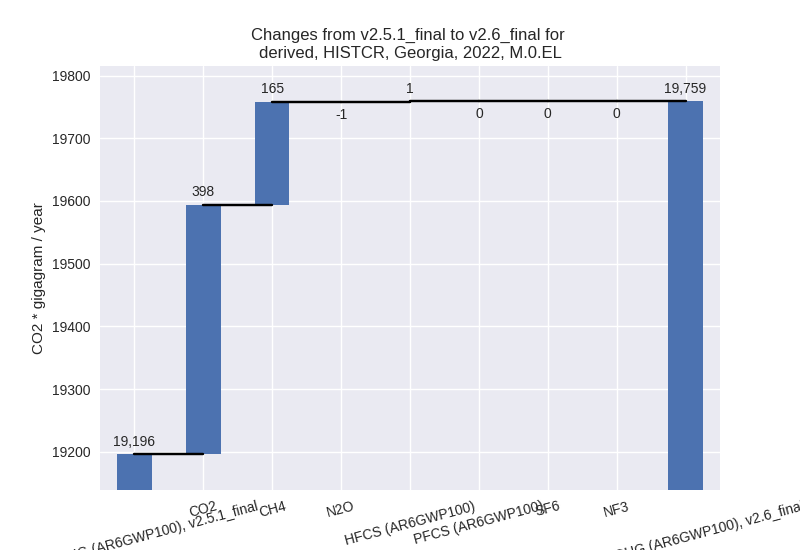
1990-2022

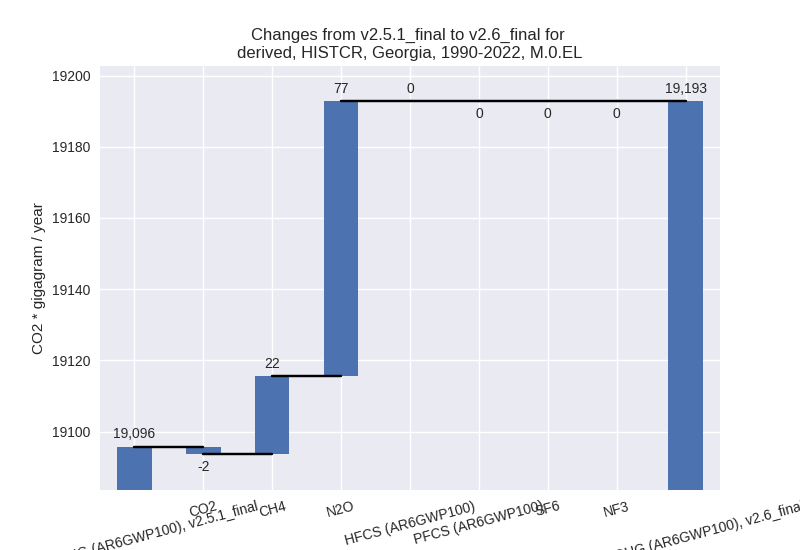
third party scenario
2022
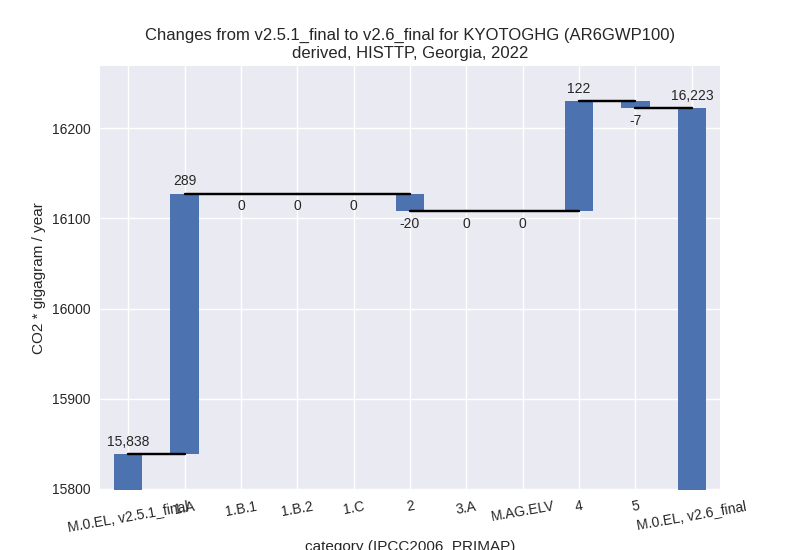
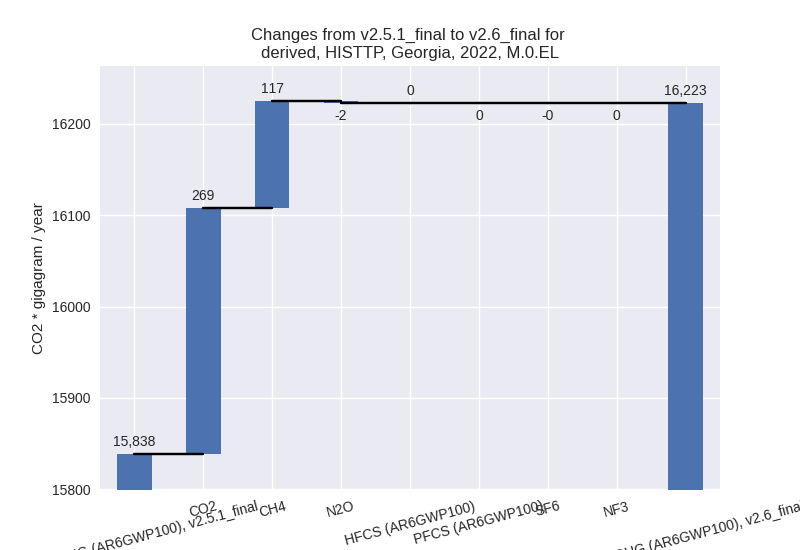
1990-2022
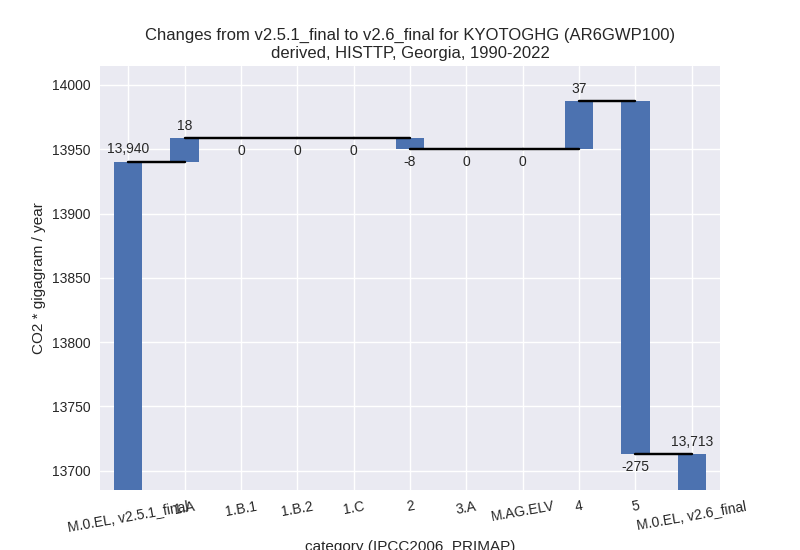
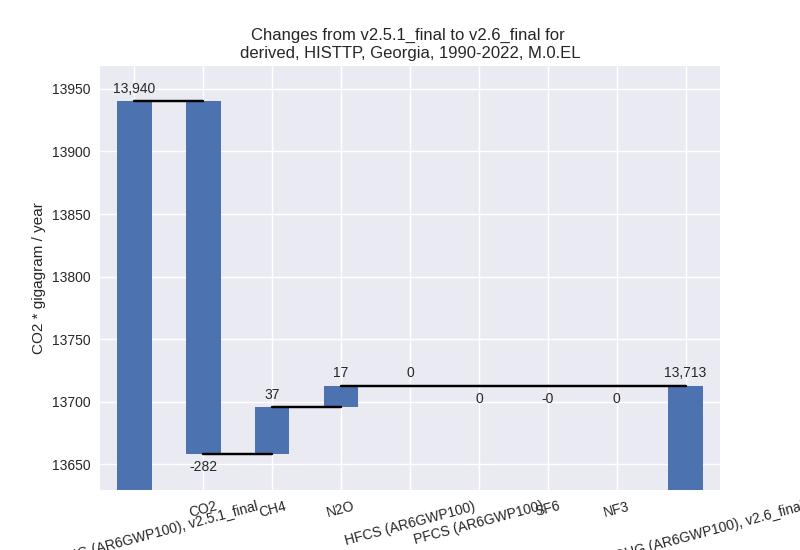
Detailed changes for the scenarios:
country reported scenario (HISTCR):
Most important changes per time frame
For 2022 the following sector-gas combinations have the highest absolute impact on national total KyotoGHG (AR6GWP100) emissions in 2022 (top 5):
- 1: 1.A, CO2 with 279.27 Gg CO2 / year (3.3%)
- 2: 4, CH4 with 155.04 Gg CO2 / year (8.0%)
- 3: 2, CO2 with 118.43 Gg CO2 / year (7.2%)
- 4: 2, CH4 with 9.55 Gg CO2 / year (10526.0%)
- 5: 5, N2O with -7.50 Gg CO2 / year (-11.9%)
For 1990-2022 the following sector-gas combinations have the highest absolute impact on national total KyotoGHG (AR6GWP100) emissions in 1990-2022 (top 5):
- 1: 5, CO2 with -289.64 Gg CO2 / year (-100.0%)
- 2: 2, CO2 with 269.82 Gg CO2 / year (21.4%)
- 3: 2, N2O with 61.30 Gg CO2 / year (12.1%)
- 4: 1.A, CO2 with 17.67 Gg CO2 / year (0.2%)
- 5: 4, CH4 with 17.41 Gg CO2 / year (1.0%)
Changes in the main sectors for aggregate KyotoGHG (AR6GWP100) are
- 1: Total sectoral emissions in 2022 are 11206.89 Gg
CO2 / year which is 56.7% of M.0.EL emissions. 2022 Emissions have
changed by 2.6% (279.27 Gg CO2 /
year). 1990-2022 Emissions have changed by 0.2% (17.67 Gg CO2 / year). For 2022 the
changes per gas
are:
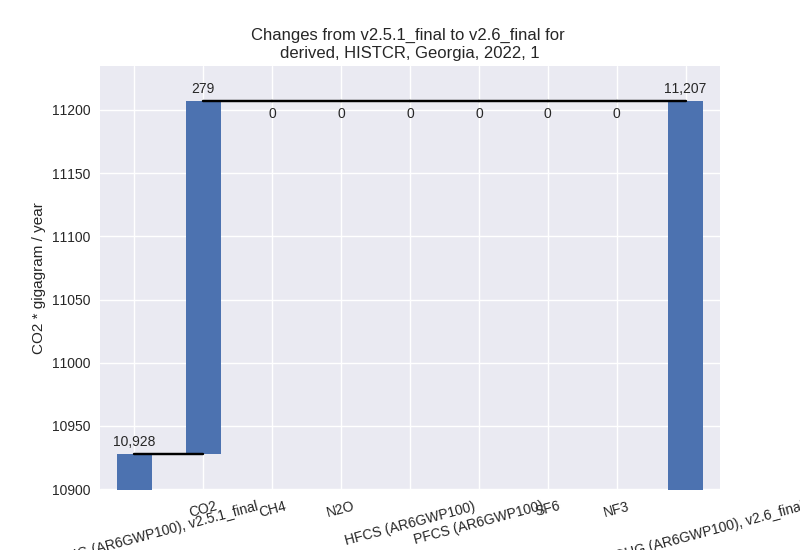
The changes come from the following subsectors:- 1.A: Total sectoral emissions in 2022 are 8805.01
Gg CO2 / year which is 78.6% of category 1 emissions. 2022 Emissions
have changed by 3.3% (279.27 Gg CO2
/ year). 1990-2022 Emissions have changed by 0.2% (17.67 Gg CO2 / year). For 2022 the
changes per gas
are:
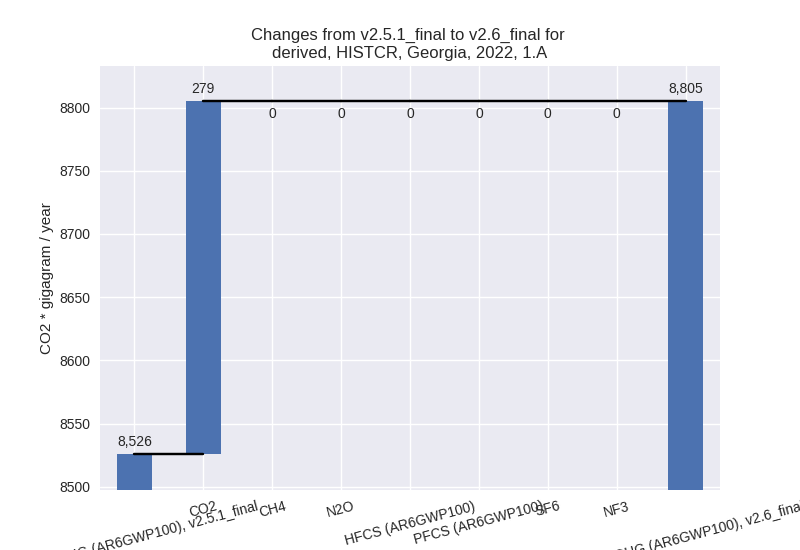
There is no subsector information available in PRIMAP-hist. - 1.B.1: Total sectoral emissions in 2022 are 77.85 Gg CO2 / year which is 0.7% of category 1 emissions. 2022 Emissions have changed by 0.0% (0.00 Gg CO2 / year). 1990-2022 Emissions have changed by 0.0% (0.00 Gg CO2 / year).
- 1.B.2: Total sectoral emissions in 2022 are 2324.03 Gg CO2 / year which is 20.7% of category 1 emissions. 2022 Emissions have changed by 0.0% (0.00 Gg CO2 / year). 1990-2022 Emissions have changed by 0.0% (0.00 Gg CO2 / year).
- 1.A: Total sectoral emissions in 2022 are 8805.01
Gg CO2 / year which is 78.6% of category 1 emissions. 2022 Emissions
have changed by 3.3% (279.27 Gg CO2
/ year). 1990-2022 Emissions have changed by 0.2% (17.67 Gg CO2 / year). For 2022 the
changes per gas
are:
- 2: Total sectoral emissions in 2022 are 2554.28 Gg
CO2 / year which is 12.9% of M.0.EL emissions. 2022 Emissions have
changed by 5.3% (129.32 Gg CO2 /
year). 1990-2022 Emissions have changed by 17.6% (335.72 Gg CO2 / year). For 2022 the
changes per gas
are:
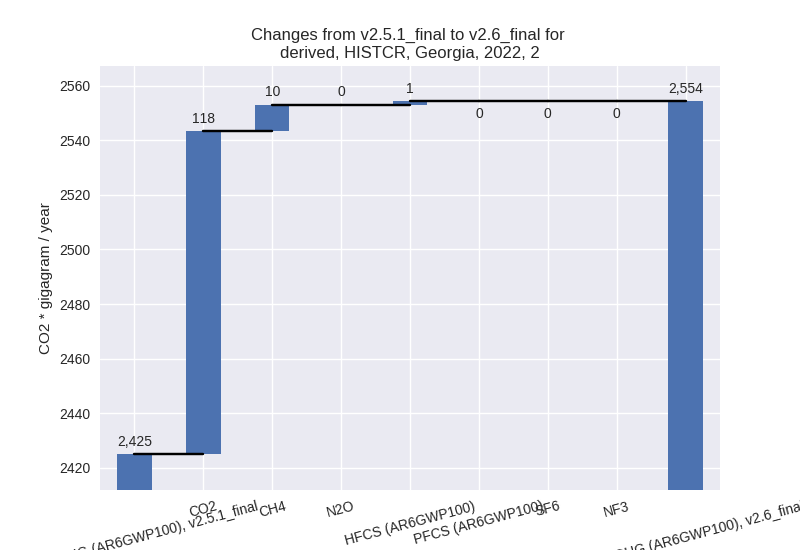
For 1990-2022 the changes per gas are: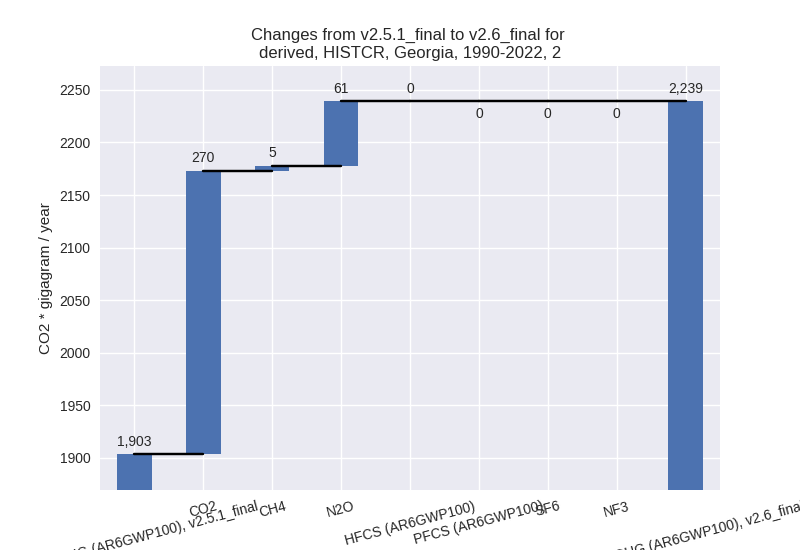
- M.AG: Total sectoral emissions in 2022 are 3782.97 Gg CO2 / year which is 19.1% of M.0.EL emissions. 2022 Emissions have changed by 0.0% (0.00 Gg CO2 / year). 1990-2022 Emissions have changed by 0.0% (0.00 Gg CO2 / year).
- 4: Total sectoral emissions in 2022 are 2159.00 Gg
CO2 / year which is 10.9% of M.0.EL emissions. 2022 Emissions have
changed by 8.1% (161.62 Gg CO2 /
year). 1990-2022 Emissions have changed by 1.0% (18.17 Gg CO2 / year). For 2022 the
changes per gas
are:
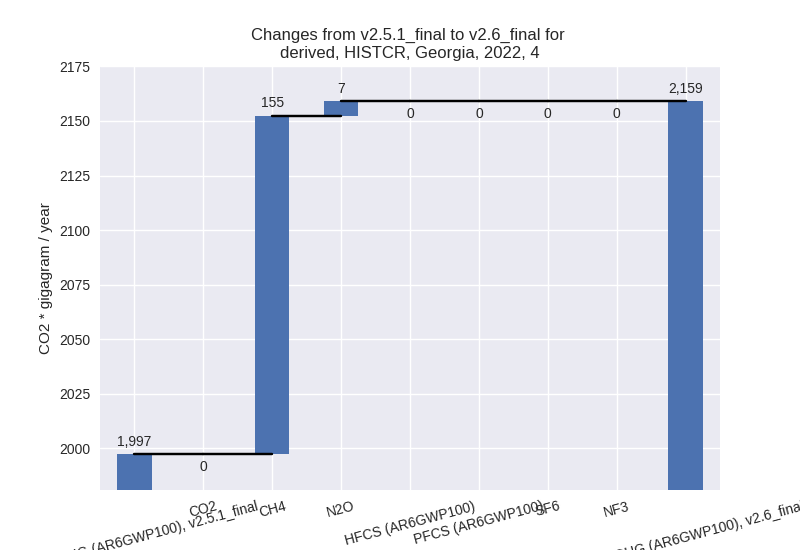
- 5: Total sectoral emissions in 2022 are 55.74 Gg
CO2 / year which is 0.3% of M.0.EL emissions. 2022 Emissions have
changed by -11.9% (-7.50 Gg CO2 /
year). 1990-2022 Emissions have changed by -80.9% (-274.58 Gg CO2 / year). For 2022
the changes per gas
are:
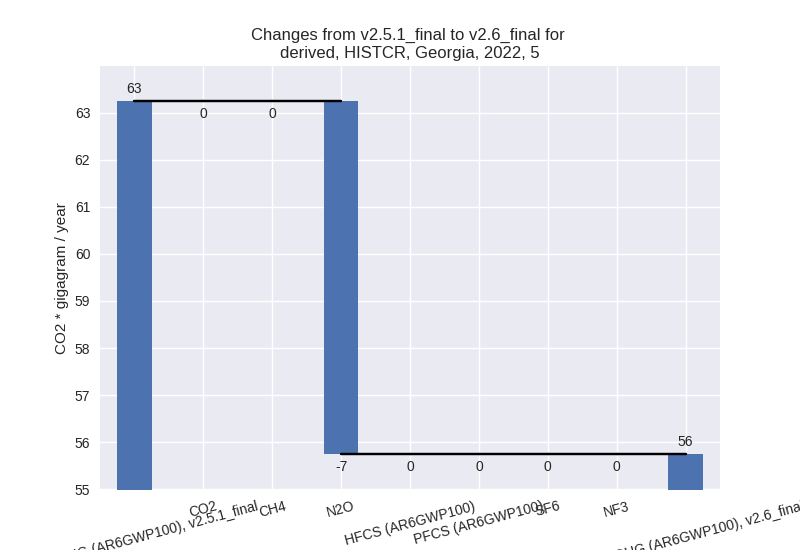
For 1990-2022 the changes per gas are: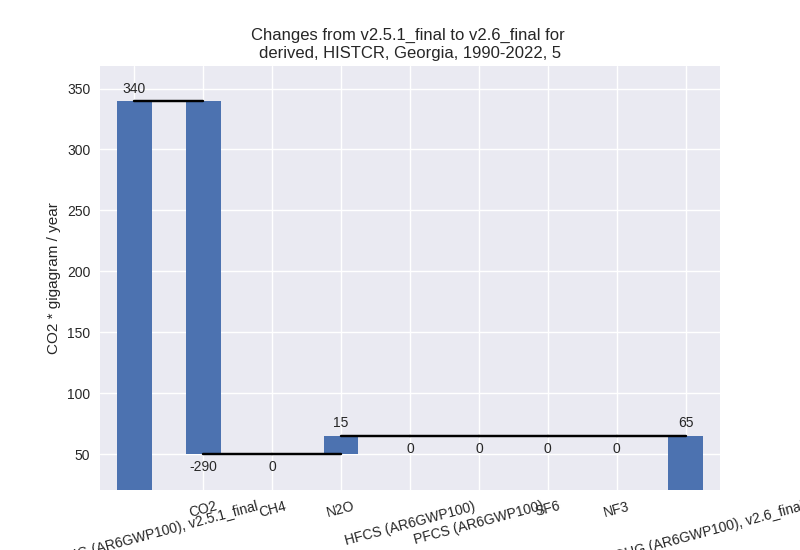
third party scenario (HISTTP):
Most important changes per time frame
For 2022 the following sector-gas combinations have the highest absolute impact on national total KyotoGHG (AR6GWP100) emissions in 2022 (top 5):
- 1: 1.A, CO2 with 289.22 Gg CO2 / year (3.3%)
- 2: 4, CH4 with 116.86 Gg CO2 / year (7.6%)
- 3: 2, CO2 with -19.92 Gg CO2 / year (-1.0%)
- 4: 5, N2O with -7.50 Gg CO2 / year (-11.9%)
- 5: 4, N2O with 5.16 Gg CO2 / year (10.7%)
For 1990-2022 the following sector-gas combinations have the highest absolute impact on national total KyotoGHG (AR6GWP100) emissions in 1990-2022 (top 5):
- 1: 5, CO2 with -289.64 Gg CO2 / year (-100.0%)
- 2: 4, CH4 with 37.47 Gg CO2 / year (2.3%)
- 3: 1.A, CO2 with 18.30 Gg CO2 / year (0.3%)
- 4: 5, N2O with 15.06 Gg CO2 / year (30.2%)
- 5: 2, CO2 with -10.75 Gg CO2 / year (-1.1%)
Changes in the main sectors for aggregate KyotoGHG (AR6GWP100) are
- 1: Total sectoral emissions in 2022 are 9191.14 Gg
CO2 / year which is 56.7% of M.0.EL emissions. 2022 Emissions have
changed by 3.2% (289.22 Gg CO2 /
year). 1990-2022 Emissions have changed by 0.2% (18.30 Gg CO2 / year). For 2022 the
changes per gas
are:
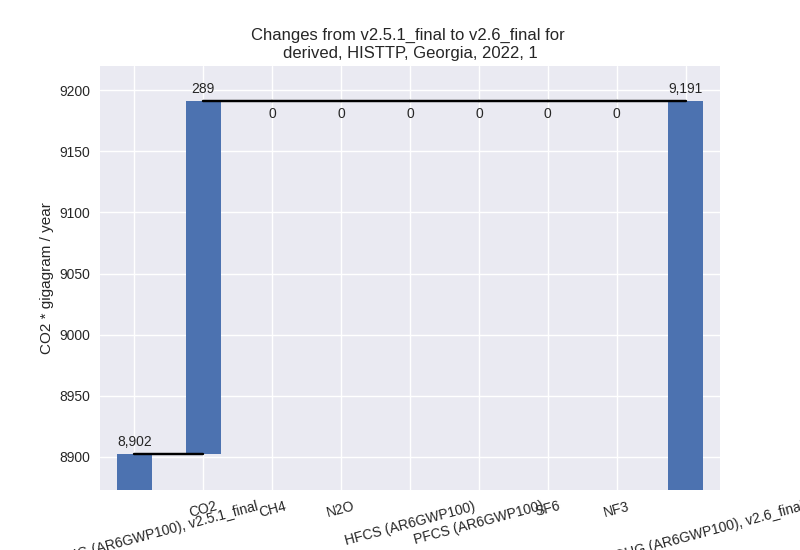
The changes come from the following subsectors:- 1.A: Total sectoral emissions in 2022 are 9097.13
Gg CO2 / year which is 99.0% of category 1 emissions. 2022 Emissions
have changed by 3.3% (289.22 Gg CO2
/ year). 1990-2022 Emissions have changed by 0.2% (18.30 Gg CO2 / year). For 2022 the
changes per gas
are:
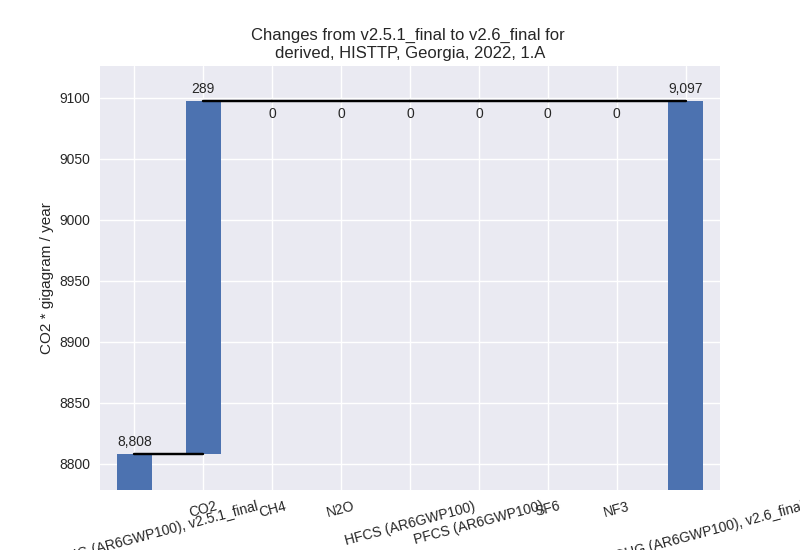
There is no subsector information available in PRIMAP-hist. - 1.B.1: Total sectoral emissions in 2022 are 5.97 Gg CO2 / year which is 0.1% of category 1 emissions. 2022 Emissions have changed by 0.0% (0.00 Gg CO2 / year). 1990-2022 Emissions have changed by 0.0% (0.00 Gg CO2 / year).
- 1.B.2: Total sectoral emissions in 2022 are 88.03 Gg CO2 / year which is 1.0% of category 1 emissions. 2022 Emissions have changed by 0.0% (0.00 Gg CO2 / year). 1990-2022 Emissions have changed by 0.0% (0.00 Gg CO2 / year).
- 1.A: Total sectoral emissions in 2022 are 9097.13
Gg CO2 / year which is 99.0% of category 1 emissions. 2022 Emissions
have changed by 3.3% (289.22 Gg CO2
/ year). 1990-2022 Emissions have changed by 0.2% (18.30 Gg CO2 / year). For 2022 the
changes per gas
are:
- 2: Total sectoral emissions in 2022 are 3207.83 Gg CO2 / year which is 19.8% of M.0.EL emissions. 2022 Emissions have changed by -0.6% (-19.71 Gg CO2 / year). 1990-2022 Emissions have changed by -0.4% (-8.34 Gg CO2 / year).
- M.AG: Total sectoral emissions in 2022 are 2055.69 Gg CO2 / year which is 12.7% of M.0.EL emissions. 2022 Emissions have changed by 0.0% (0.00 Gg CO2 / year). 1990-2022 Emissions have changed by 0.0% (0.00 Gg CO2 / year).
- 4: Total sectoral emissions in 2022 are 1712.12 Gg
CO2 / year which is 10.6% of M.0.EL emissions. 2022 Emissions have
changed by 7.7% (122.02 Gg CO2 /
year). 1990-2022 Emissions have changed by 2.2% (37.23 Gg CO2 / year). For 2022 the
changes per gas
are:
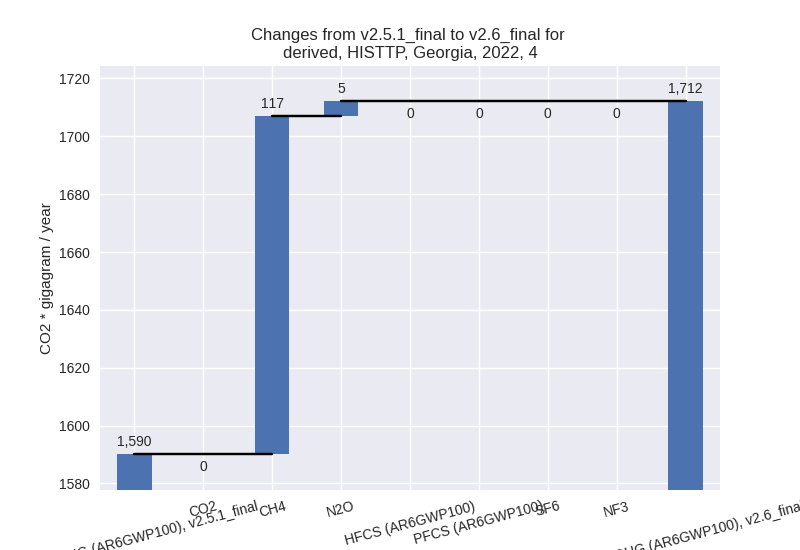
For 1990-2022 the changes per gas are: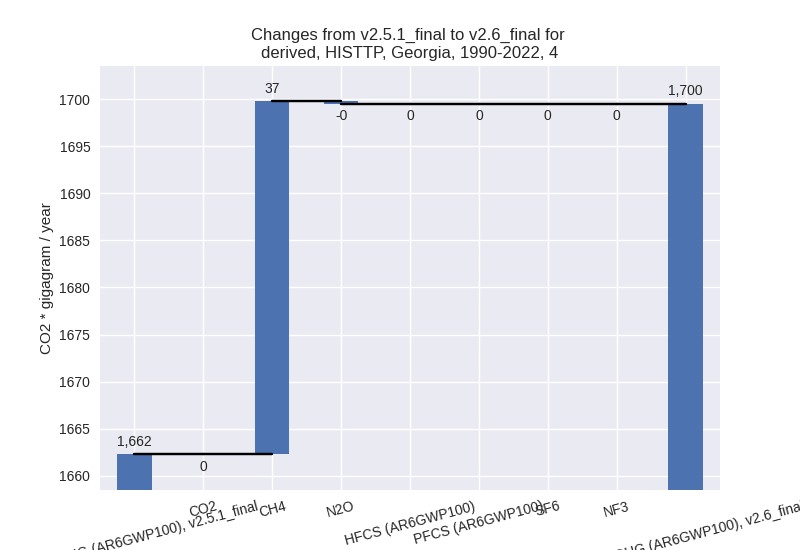
- 5: Total sectoral emissions in 2022 are 55.74 Gg
CO2 / year which is 0.3% of M.0.EL emissions. 2022 Emissions have
changed by -11.9% (-7.50 Gg CO2 /
year). 1990-2022 Emissions have changed by -80.9% (-274.58 Gg CO2 / year). For 2022
the changes per gas
are:

For 1990-2022 the changes per gas are: